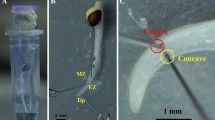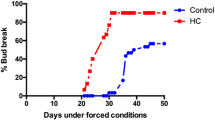Abstract
Transport of 1-14C-IAA in successive stem segments ofCuscuta was strictly basipetal in growing and non growing regions of the vine with a flux velocity of 10–12 mm/h (intercept method). This transport showed a distinct peaked profile, increasing from a low value at 10 mm from the apex to a maximum between 50 and 90 mm before declining to a low value again around 160 mm at which elongation growth ceased. The IAA transport profile paralleled the in vivo growth rate profile, though the latter peaked ahead of transport. A better correlation was observed between the profile of growth responsiveness of the vine to exogenous IAA application and the profile of IAA transport. Growth responsiveness was determined as the differential in growth rate of stem segments in vitro in the absence and presence of growth optimal concentration of IAA (10 μm). Retention of exogenous IAA in the stem was maximal where transport decreased, and this coincided with the region of maximal conjugation of applied 1-14C-IAA to aspartic acid to form indoleacetylaspartate (IAAsp). In addition to aspartate, IAA was conjugated to a small extent to an unidentified compound. IAA destruction by decarboxylation was greatest where transport was low, particularly in the nongrowing region, where lignification occurred (i.e., beyond 180 mm). At concentrations up to 20 μM, a pulse of 1-14C-IAA chased by “cold” IAA moved as a peak (with a peak displacement velocity of 12–18 mm/h) in the “growth” region of the vine, but became diffusionlike where growth either fell off steeply or ceased. At a higher (50 μM) IAA concentration, though uptake was not saturated, transport in the growth region became diffusionlike, indicating saturation of the system. Reduced IAA flux in the region where growth responsiveness to IAA declined coincided with the region of increased IAA conjugation. However, it cannot be concluded whether increased IAA conjugation was the cause or effect of decreased IAA flux. Application of benzyladenine to the vines in vivo, a treatment that elicited haustoria formation by 72 h, resulted in the inhibition of both IAA transport and elongation growth rate in the subapical region. In vitro treatment of vine segments with BA similarly increased IAA retention and decreased IAA transport. IAA loss was suppressed, and conjugation to IAAsp was enhanced.
Similar content being viewed by others
Abbreviations
- BA:
-
benzyl adenine
- GA:
-
gibberellic acid (GA3)
- HPLC:
-
high-pressure liquid chromatography
- IAA:
-
indole-3-acetic acid
- 1-14C-IAA:
-
carboxyl-labeled IAA
- IAAsp:
-
indole-3-acetylaspartic acid
- 1-14C-NAA:
-
1-14C-α-napthaleneacetic acid
- POPOP:
-
(1,4-bis(5-phenyl-2 oxazolyl)benzene
- PPO:
-
diphenyloxazole
- PUR:
-
pulse uptake and retention
- TLC:
-
thin-layer chromatography
References
Coleman WK, Thorpe TA (1985) Polarity. In: Pharis RP, Reid DM (eds) Hormonal regulation of development. III. Encyclopedia of plant physiology, New Series 11. Springer, New York, pp 116–132
Fuchs Y, Lieberman M (1968) Effect of kinetin, IAA and gibberellic acid on ethylene production and their interactions in growth of seedlings. Plant Physiol 43:2029–2036
Goldsmith MHM (1977) The polar transport of auxin. Annu Rev Plant Physiol 28:439–478
Goldsmith MHM (1982) A saturable site responsible for polar transport of indole-3-acetic acid in sections of maize coleoptile. Planta 155:68–75
Goldsmith MHM, Thimann KV (1962) Some characteristics of movement of indole acetic acid in coleoptiles ofAvena. I. Uptake, destruction, immobilization and distribution of IAA during basipetal translocation. Plant Physiol 37:492–505
Guern J, Kurkdjian A, Mathieu Y (1982) Hormonal regulation of intracellular pH: Hypotheses versus facts. In: Wareing PF (ed) Plant growth substances 1982. Academic Press, New York, pp 427–437
Hertel R, Lomax TL, Brigs WR (1983) Auxin transport in membrane vesicles fromCucurbita pepo L. Planta 157:193–201
Jacob WP (1972) The movement of plant hormones: Auxin, gibberellins and cytokinins. In: Carr DJ (ed) Plant growth substances 1970. Springer, New York, pp 701–709
Jacob WP (1979) Plant hormones and plant development. Cambridge University Press, London
Lau OL, Yang SF (1973) Mechanism of a synergistic effect of kinetin on auxin-induced ethylene production; suppression of auxin conjugation. Plant Physiol 51:1011–1014
Mahadevan S, Stowe BB (1972) An intermediate in the synthesis of glucobrassicins from 3-indoleacetaldoxime by woad leaves. Plant Physiol 50:43–50
Maheshwari R, Shailini C, Veluthambi K, Mahadevan S (1980) Interaction of gibberellic acid and indole-3-acetic acid in the growth of excisedCuscuta shoot tipsin vitro. Plant Physiol 65:186–192
Mollan RC, Donnelly DMX, Harmey MA (1972) Synthesis of indole-3-acetylaspartic acid. Phytochemistry 11:1485–1488
Nagaiah K, Kumar SA, Mahadevan S (1977) L-phenylalanine ammonia-lyase from the lignified and non-lignified regions ofCuscuta chinensis. Phytochemistry 16:667–671
Naqvi SM, Gordon SA (1965) Auxin transport in flowering and vegetative shoots ofColeus blumei Benth. Plant Physiol 40:116–118
Paliyath G, Maheshwari R, Mahadevan S (1978) Initiation of haustoria inCuscuta by cytokinin application. Curr Sci 47:427–429
Rajagopal I, Ramasubramanian TS, Paliyath G, Mahadevan S (1988) Hormones andCuscuta development. Interaction of cytokinin and indole-3-acetic acid in the growth and curvature of subapical stem segments. J Plant Growth Regul 7:121–132
Ramasubramanian TS, Paliyath G, Rajagopal I, Maheshwari R, Mahadevan S (1988) Hormones andCuscuta development. In vitro induction of haustoria by cytokinin and its inhibition by other hormones. J Plant Growth Regul 7:133–144
Rubery PH (1980) The mechanism of transmembrane auxin transport and its relation to the chemiosmotic hypothesis of the polar transport of auxin. In: Skoog F (ed) Plant growth substances 1979. Springer, New York, pp 50–60
Sembdner G, Gross D, Liebisch HW, Schneider G (1980) Biosynthesis and metabolism of plant hormones. In: MacMillan J (ed) Hormonal regulation of development. I. Encyclopedia of plant physiology, New Series 9. Springer, New York, p 364
Sze H (1985) H+-translocating ATPases: Advances using membrane vesicles. Annu Rev Plant Physiol 36:175–208
Went FW, Thimann KV (1937) Phytohormones. Macmillan, New York, p 93
Zeroni M, Hall MA (1980) Molecular effects of hormone treatment on tissue. In: MacMillan J (ed) Hormonal regulation of development. I. Encyclopedia of plant physiology, New Series 9. Springer, New York, p 530
Author information
Authors and Affiliations
Rights and permissions
About this article
Cite this article
Paliyath, G., Rajagopal, I., Unnikrishnan, P.O. et al. Hormones andCuscuta development: IAA uptake transport and metabolism in relation to growth in the absence and presence of applied cytokinin. J Plant Growth Regul 8, 19–35 (1989). https://doi.org/10.1007/BF02024923
Received:
Accepted:
Issue Date:
DOI: https://doi.org/10.1007/BF02024923




